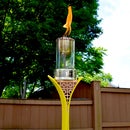Introduction: DIY Project: How to Make a Workbench
I love having a stationary workbench in my shop. While many benches I build are mobile by design—whether for the job site or just to move around the shop—I like to have a fixed, sturdy, flat place to do all kinds of stuff from sharpening to paperwork.
As usual, however, I want lots of utility and versatility without spending a lot of money. And I want to maximize the space, which this workbench does nicely. Because it is wall-mounted there are no legs to get in the way (like when I’m sweeping up) and I can store things I don’t use that often underneath.
And, as you may be able to tell from the picture, this workbench is in an old house. So even if I wanted to build a 4-legged workbench, I’d need about 300 shims under the legs to accommodate the undulating concrete.
All it takes to build is some 2×4, fasteners, and 5/8-inch BC plywood.
Step 1: I Like a Bench at Typical Counter Height: 36-inches Off the Floor.
Thirty-six inches off the floor is a nice height. Also, the more your house looks like it was a location for Silence of the Lambs, the better this workbench is.
Step 2: Strike a Level Line. Destroy Pencil.
A level line is next. When scribing on concrete or masonry like this, your pencil will instantly be torched. Good thing this link will take you to a terrific video on how to sharpen a carpenter’s pencil.
Step 3: Fasten the Ledger to the Wall.
On this workbench, I installed the sides onto the ledger first. It makes getting the angle for the legs (next) easier. Make sure the sides are level before laying out and fastening the legs.
Tip: Use concrete screws or expansion anchors to fasten to masonry or concrete.
Step 4: Run a Leg Back to the Wall.
For a workbench like this, I like the leg to be at least 24-inches long. To get the angle where the leg meets the side, I cut a 45-degree angle off the wall-side, then just put the piece in place and trace the top.
Step 5: Add Ribs to Support the 5/8-inch Plywood Top.
I like to install ribs every 24-inches or so before putting on the front piece.
Step 6: Add the Front.
Adding the front piece is: (A) terrifying, (B) agonizing, (C) fun?
Step 7: Add the Top.
Adding the top gives me an excuse to use one of my handiest tools, my narrow crown stapler. It’s awesome for this kind of project because the staples hold fast and (even though they’d work fine) leave a smaller countersink than screw heads. Plus they go in fast and make a cool noise.
5/8-inch plywood works great. Run a router with a chamfer bit to ease the square edge.
Step 8: Customize.
Nails or screws are all I use. And rhymes. I use rhymes too.
There are fancier ways to organize a workshop. Drawers, doors, closets, etc. But for me, in a shop like this, I can finish something like this (A) in my lifetime and (B) it’s easy to build. It’s inexpensive and delivers buckets of utility. It doesn’t do everything—closets and cases are great for stuff like paint cans and a zillion other things—but this creates a space for stuff I use that I can see it and grab it when I need it. You with me on this?













